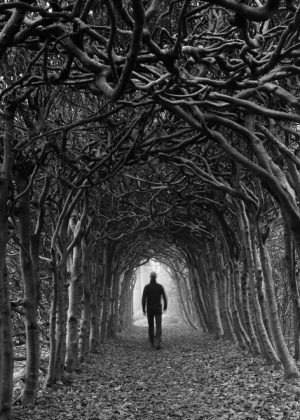 “Bereavement is the deepest initiation into the mysteries of human life, an initiation more searching and profound than even happy love.” —Dean Inge
“Bereavement is the deepest initiation into the mysteries of human life, an initiation more searching and profound than even happy love.” —Dean Inge
One of the most profound, and certainly one of the most tragic, human experiences is experiencing the death of a loved one. A death is life-changing knowledge, knowledge you have not asked for.
In my role as a therapist bearing witness to the grief of the people I treat, I see bereavement as a form of initiation. Bereavement can have both healing and transformative potential, when worked with on a deeper level—especially in the realm of dreams and myth.
Grief and the Underworld
In Joseph Campbell’s description of the monomyth, or “Hero’s Journey,” the initiate cannot fully transform before venturing into the Underworld. Depending on the myth, the Underworld may take the form of a dark forest, barren desert, a mountain, a cave, or even Hades or Hell itself.
Many of the people I see in my practice describe the death of a loved one as a dark forest, a black hole, or a wilderness. In The Wilderness of Grief, death educator and grief counselor Alan Wolflelt speaks of this:
“Think of your grief as a wilderness—a vast, mountainous, inhospitable forest. You are in the wilderness now. You are in the midst of often brutal surroundings. You are cold and tired. Yet you must journey through the wilderness.”
Before this descent, people may come into sessions feeling “raw” or as if they are living in another realm. They don’t feel as if they are part of this world anymore. They might feel numb or dissociated. Memory gaps often occur. Some might not believe the death is real, even though their loved one was ill for many months, or even years. This, of course, is quite normal.
They are in the wilderness of their grief.
Tasks of Grief
In many myths, the protagonists must perform tasks along their journey. Greek mythology’s Orpheus used music to gain favor of the many keepers of the gates in the Underworld to visit Eurydice, his dead wife, and bring her back. In Sumerian mythology, the descent of Inanna (goddess of love, procreation, and war) into the Underworld involved her removing seven articles of clothing, one at each gate, so she could attend her sister’s husband’s funeral rites.
For death educator pioneer Elizabeth Kubler-Ross, healing from the death of a loved may encompass several stages: denial, anger, bargaining, depression, and acceptance.
But in The Six Needs of Mourning, Alan P. Wolfelt saw grief as more of a process that involved tasks:
- Task 1: Accepting the reality of the death
- Task 2: Letting yourself feel the pain of the loss
- Task 3: Remembering the person who died
- Task 4: Developing a new self-identity
- Task 5: Searching for meaning
- Task 6: Receiving on-going support
Performing these tasks (in no particular order, because grief is unique and cyclical rather than linear) has proved vital for many in the healing of grief. Many of these tasks are amplified in our dreams, especially when we are visited by the loved one who died.
Grief and Visitation Dreams
A visitation dream is the experience of the dead visiting us in our dreams. This experience might take the form of an in-person visitation, a verbal message such as a simple “Hello”, a sensation or sense of the person’s presence, or even an animal or another form. Many people I have worked with have shared they have been visited by birds and felt comforted, as if their loved one was sending them a message.
Many people have reported healing effects from a visitation dream, especially when they were in need of comfort and/or had been questioning their faith. This type of dream is a universal phenomenon that has been reported over centuries and around the world. When you know how to work with these dreams, they may have the potential to heal grief and restore hope.
Working with Grief
Each person’s grief is like a fingerprint: as unique as their relationship with the loved one who died. This is why I find working with dreams to be especially powerful. The state of loss can be very frightening and confusing, and dreams can offer a map to the terrain of their grief and serve as something tangible to hold onto in the face of the unknown.
When working with grief dreams, especially visitation dreams, it is imperative to trust in the process. There have been many controversies regarding the importance of whether or not these visitations dreams or lucid visions are real. I take the view that it is not an issue of what is real but an issue of what has been transformed by the experience. What remains constant, regardless through what lens or belief system a person holds to, is that these dreams and visions have brought transformation, as courage, calm, and even excitement, in the face of the biggest mystery of all: our own mortality.
In my next article, I will focus on the specific mourning task of Coping with the Reality of the Loss and how this task shows up in our dreams.
References:
- Bulkeley K., & Bulkeley P. (2005). Dreaming beyond death: A guide to pre-death dreams and visions. Boston, MA: Beacon Press.
- Campbell, J. (1976). The hero with a thousand faces. Bollingen Series 17. Princeton, NJ: Princeton University Press.
- Eliade, M. (1958). Rites and symbols of initiation: Mysteries of birth and rebirth. (W. Trask, Trans.). London, England: Harvill Press.
- Evans-Wentz, W. Y., (Ed.). (2000) The Tibetan book of the dead: Or the after-death experiences on the Bardo plane, according to Lama Kazi Dawa-Samdup’s English rendering (4th ed.). Oxford: Oxford University Press
- Garfield, P. (1997). The dream messenger: How dreams of the departed bring healing gifts. Simon & Schuster.
- Moss, R. (2005). The dreamer’s book of the dead: A soul traveler’s guide to death, dying, and the other side. Rochester, Vermont: Destiny Books.
- Sparrow, G. S. (n.d.). The dream as a path of initiation. Retrieved from http://www.edgarcayce.org/are/pdf/sparrow_dreams.pdf
- Wolfelt, Alan P. (2006). Companioning the bereaved. Companion Press, Fort Collins, CO.
- Wolfelt, Alan P. (2007). The wilderness of grief. Companion Press, Fort Collins, CO.
© Copyright 2016 GoodTherapy.org. All rights reserved. Permission to publish granted by Linda H. Mastrangelo, MA, LMFT, Dreamwork Topic Expert Contributor
The preceding article was solely written by the author named above. Any views and opinions expressed are not necessarily shared by GoodTherapy.org. Questions or concerns about the preceding article can be directed to the author or posted as a comment below.

 Initiation Dreams, Part I: Big Dreams That Change Our Lives
Initiation Dreams, Part I: Big Dreams That Change Our Lives The Healing Image: Why Your Dreams Deserve Your Respect
The Healing Image: Why Your Dreams Deserve Your Respect Transformative Grief, Part II: A Guide to Living with Loss
Transformative Grief, Part II: A Guide to Living with Loss